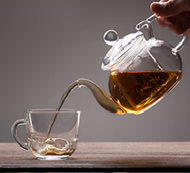Got Tea? It’s the Fastest-Growing Beverage
Posted by BY Emma Alois on May 19th 2017

In recent years, tea has been outperforming carbonated soda drinks and giving coffee a run for its money. While soda consumption has been on a steady decline since the late ’90s, the US tea industry has skyrocketed—from $1.8 billion in 1990 to $10.8 billion in 2014!
According to the Tea Association of the USA, tea is the second-most-consumed beverage in the world (after water), and it’s found in 80% of US households. Experts believe the popularity of tea will only continue to grow.
The Upward Trend of Tea Consumption in the United States
Soda has long been one of the most beloved drinks in America, so its declining sales have come as a surprise to many. Some analysts correlate the decrease in soda consumption with an increased awareness of obesity and a growing health consciousness in the early 2000s. Tea, on the other hand, is considered a guilt-free beverage option. Its benefits include boosting the immune system, fighting infection, and being loaded up with antioxidants.
Health-conscious millennials have taken note of tea’s attractive qualities. A survey conducted by YouGov revealed that consumers from ages 18 to 29 are evenly split between their preference for coffee and tea: 42% prefer coffee, while 42% prefer tea.
But it would be inaccurate to credit only millennials for the rising popularity of tea. The United States has been undergoing a consumption revolution for years now, with Americans opting for healthier food and beverage options across all age groups. It’s a pattern of behavior that will only continue, and the industry is responding by putting more nutritious options on the market.
Among beverage companies, tea has been developed into more than just a single-use tea bag. Now aisles in supermarkets and gas stations carry prepackaged tea in cans and bottles. Coca-Cola recognized years ago that tea was the new hot beverage to invest in, creating not one but two tea brands: Golden Peak and Fuze (which reportedly earn $1 billion in revenue).
Tea Farming Is the New US Industry
Despite its dramatic history with tea (see: The Boston Tea Party), the United States has no tradition of growing tea. Almost all US tea is imported from Canada, Argentina, and China, along with several Southeast Asian countries.The tea-growing industry is easy to enter. There are just a few farms in a handful of states, with the highest concentration of farms in Hawaii; its mineral-rich soil from volcanic ash makes it a perfect place to grow tea. With the minimal competition, start-up tea farms can develop their growing methods at a steady pace, without the fear of getting pushed out by a large corporation.Tea can be grown in different climates. Different environments require their own sets of processes to cultivate tea leaves, so there are options to grow in many places.
What’s Next for the US Tea Industry
Not only will we continue to see tea on mass-market retailers’ shelves, but a blend of beverages will become a growing trend—such as tea + energy drinks or tea + alcohol. Premium drink options with higher price tags will be another trend in the future.
Tea companies will likely use the locavore movement as an appealing marketing opportunity, a strategy that aligns very well with restaurants. Following in the footsteps of wineries and microbreweries, tea companies will reach out to make connections with local restaurants and bars.
Rather than wait for a call, reach out to a US tea company, and replace the generic tea you might be serving with their product. You can play up the tea’s appeal by explaining to customers that it is an American product, detailing where and how it’s grown. Background stories are an effective selling tool for restaurant menus, helping to paint a vivid and positive image of your menu items and brand. By serving American tea at your restaurant, you’ll help to kickstart a new industry.

